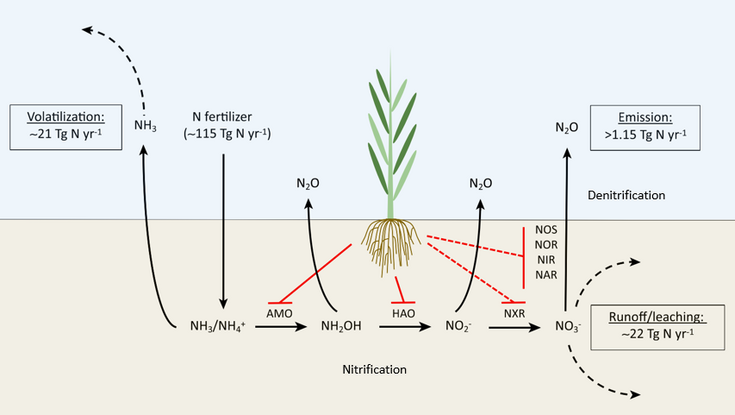Metabolomics for the Investigation of Biological Nitrification Inhibitors in the Rhizosphere
SUPERVISORS: Rainer SCHUHMACHER
PROJECT ASSIGNED TO: Christina MAISL
The massive and ever increasing use of nitrogen fertilizers in agriculture has a negative impact on the environment and the climate. Poor nitrogen use efficiency (NUE) leads to large nitrogen fertilizer losses to the environment. These losses take the form of ammonia volatilization, denitrification (direct nitrous oxide emission) and nitrate leaching (compare Figure 1), all of which have a negative impact on the environment and the climate in the form of production of potent greenhouse gases and eutrophication of fresh and marine waters for example.
If nitrogen loss in agriculture is reduced by increasing NUE, the negative effects of nitrogen fertilizers could be mitigated. One approach to increase NUE is to reduce the rate of nitrification i.e. the oxidation of ammonia to nitrate by ammonia- and nitrite oxidizing microorganisms. In principle, synthetic nitrification inhibitors (SNIs, such as nitrapyrin) can be used for that purpose. However, SNIs can negatively affect the growth and health of plants. Biological nitrification inhibitors (BNIs; such as linoleic or linolenic acid) directly produced by plants and released via their roots are therefore a promising alternative to the SNIs currently in use. BNIs can suppress up to 90% of nitrification via inhibition of ammonia monooxygenase and hydroxylamine oxidoreductase and lead to an increased bioavailability and retention of nitrogen in the soil, improving the growth of plants and the effectiveness of nitrogen use. A strong inhibition of nitrifying bacteria was found in some grasses and crops, for example sorghum and the tropical pasture signal grasses. Hence, it is believed that the production of BNIs in plants is a genetically determined trait that could be enhanced by breeding. Altogether, BNIs would be an environmentally conscious and sustainable alternative to SNIs.
The process of BNI characterization is a demanding and multi-facetted task. Although some BNIs are already known, there is a lack of quick and suitable methods for their detection and characterization. The effects and modes of action of individual BNIs have been researched, but so far there are no studies that investigate BNI in situ mobility, stability, nitrification inhibition efficiency or their influence on the microbiome in soil cultures and on the NUE of plants. Before BNIs can be used in agriculture, a better understanding is needed how they affect soil microbiology, plant health and the nitrogen cycle.
In this project the aim is to identify novel and characterize known biological nitrification inhibitors (BNIs), study their inhibition efficacy of ammonia oxidizing microorganisms and their mobility and stability in soil. Moreover the effect of BNIs on nitrogen cycling, nitrogen use efficiency in crop plants and on microbial communities in soil.

Figure 1: Effects of nitrogen fertilizer on soil (Adapted from Coskun et al. (2017));
AMO = ammonia monooxygenase, HAO = hydroxylamine oxireductase, NXR = nitrous oxireductase, NAR = nitrate reductase, NIR = nitrite reductase, NOR = nitric oxide reductase, NOS = nitrous oxide reductase.
This dissertation is part of a FWF research project called “Interplay between Biological Nitrification Inhibitors, Nitrogen Cycling, and Agronomic Nitrogen Use Efficiency (playNICE)”, which is carried out in collaborative effort of the Centre for Microbiology and Environmental Systems Science (CMESS) at the University of Vienna, and the Institute of Bioanalytics and Agro-Metabolomics (iBAM) at the University of Natural Resources and Life Sciences Vienna.
